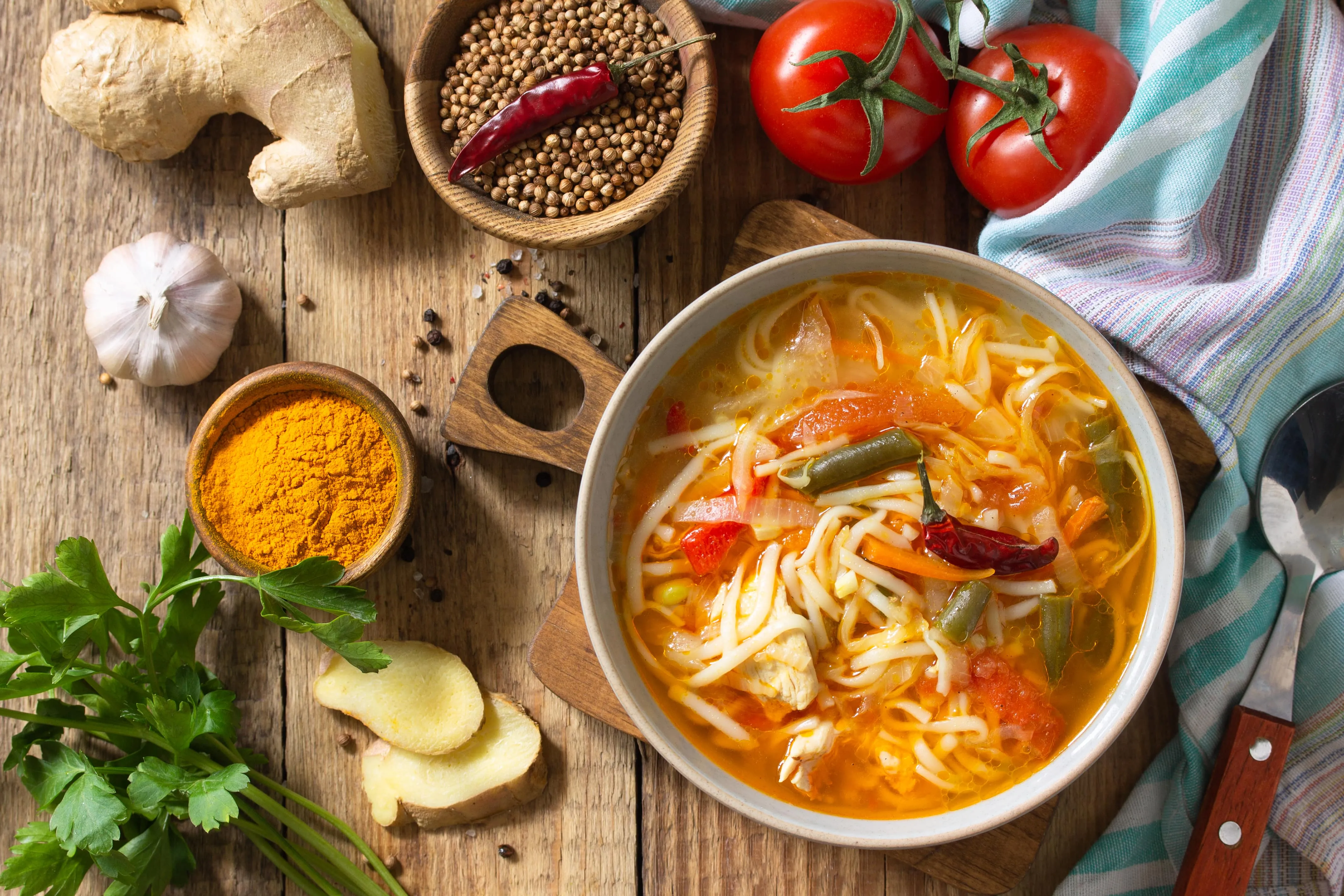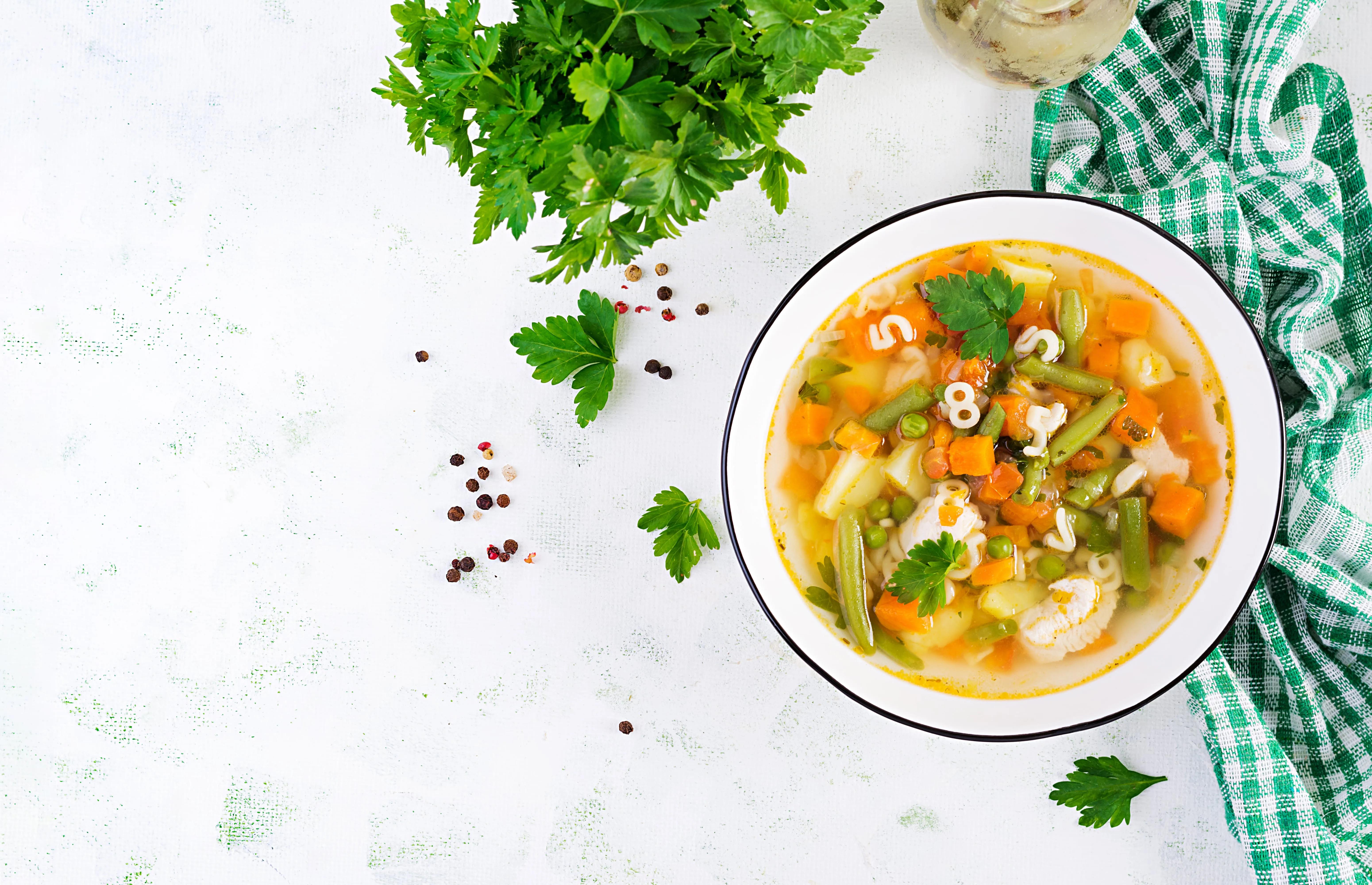Key Takeaways
- Not all soups are created equal; broth-based, veggie-packed recipes with lean protein and healthy fats help keep glucose levels steady while offering cozy comfort.
- Build your bowl with balance: combine fiber-rich carbs like lentils or squash with non-starchy veggies and a protein source for lasting energy.
- Try simple swaps such as replacing cream with blended beans or cauliflower, and use Signos’ insights to see how your favorite soups affect your blood sugar in real time.
that {{mid-cta}}
There’s no doubt about it: Fall is quintessential soup season. There’s something about the fall foliage, cooler temperatures, and grayer skies that makes you want to cozy up with a warm bowl of soup. And while soup may seem like an obvious healthy choice, not all soup recipes support stable blood sugar levels and metabolic health. Don’t worry: Signos has you covered with tips for the perfect bowl of soup that delivers steady energy without the glucose highs and lows.
Why Soups Can Be a Metabolic Double-Edged Sword

You probably think of soup as a healthy option, and while that reputation is mostly deserved, there are some things (ingredients and bases) that can make a soup so great for blood sugar.
- Creamy or starchy soups (think potato chowder or traditional chicken noodle soup) can quickly raise blood glucose levels. White flour, noodles, and heavy cream digest fast, flooding your bloodstream with glucose and triggering an insulin spike.
- Broth-based and veggie-forward soups deliver fiber, water, and nutrients that promote fullness and balance. A soup full of veggies and broth allows you to enjoy more volume with fewer calories. The fiber slows digestion, increases fullness and satisfaction, and prevents glucose highs.
- Hidden ingredients also play a role. Canned or restaurant soups often sneak in sodium, added sugars, and refined starches that can work against your health goals. The key is knowing what’s in your bowl and how to build a better one at home.
The Anatomy of a Glucose-Friendly Soup

Building a soup that’s good for blood sugar starts with a simple formula: base + protein + fiber + healthy fat + flavor. Here’s how to layer each one for balance and taste:
1. Choose a Smart Base
Start with a broth or stock that supports hydration and adds minerals. Bone broth, vegetable broth, or miso add electrolytes and umami flavor without the glucose hit of cream. If you prefer thicker soups, try blending part of the soup with cauliflower, beans, or cashews to naturally create a velvety texture.
2. Prioritize Protein
Protein is your blood sugar’s best friend: it slows digestion, promotes fullness, and helps blunt post-meal glucose spikes.1
- Animal-based options: chicken, turkey, or fish
- Plant-based options: lentils, chickpeas, white beans, or tofu
Aim for 20-25 grams of protein per meal to keep your glucose and energy levels steady.
3. Go for Fiber-Rich Carbs
Carbs aren’t the enemy, and you don’t need to avoid them. Choose diabetes-friendly complex carbohydrates that digest slowly, like:
- Legumes (beans, lentils, or split peas)
- Whole grains (barley, quinoa, or brown rice)
- Starchy vegetables (sweet potatoes or squash)
These options provide soluble fiber, which forms a gel-like substance in the gut that slows glucose absorption.
4. Load Up on Non-Starchy Veggies
Vegetable soup is the most glucose-friendly soup. Non-starchy options like zucchini, peppers, mushrooms, spinach, kale, carrots, and cruciferous veggies add bulk and micronutrients while helping regulate digestion and inflammation. Aim for at least two to three cups of vegetables per serving; more color means more antioxidants.
5. Add Healthy Fats for Staying Power
Healthy fats increase satiety and support heart health and good metabolism. A drizzle of olive oil, or topping your soup with avocado, hemp seeds, or pumpkin seeds, adds flavor and helps stabilize glucose after meals.
6. Season with Spices that Support Metabolic Health
Herbs and spices do more than add flavor. Compounds in turmeric, ginger, cinnamon, garlic, and cayenne may support insulin sensitivity and reduce inflammation.2 Fresh herbs like parsley or cilantro also add a nutrient boost.
Metabolic Playbook: Soup Strategies for Fall

Adding nutrient-rich soups to your routine doesn’t have to be time-consuming or complicated. Here are some easy ways to make it work for you:
1. Batch Prep for the Week
Soups reheat well, making them ideal for meal planning. Batch-cook a big pot on Sunday, portion it into glass containers, and freeze or refrigerate for quick lunches. Just remember to store noodles or grains separately so they don’t over-absorb liquid.
2. Pair it with Protein for Balance
A bowl of soup can be satisfying on its own, but pairing it with a side of protein, like a boiled egg, cottage cheese, or some deli turkey, creates a complete, balanced meal.
3. Upgrade Your Creamy Soups
Instead of heavy cream, use blended cauliflower, white beans, or soaked cashews to thicken your soup while adding fiber and plant-based protein. You can also try blended cottage cheese in place of heavy cream for a probiotic- and protein-rich base. The texture stays indulgent, but your glucose stays steady.
4. Be Smart About Sides
If you crave bread or crackers, opt for high-fiber or seed-based versions. You’ll still get the comforting crunch without the blood sugar spike.
Sample Glucose-Friendly Soup Upgrades

Soup is versatile by design: one pot, endless options. Here are a few ways to give traditional recipes a metabolic makeover:
Butternut Squash Soup
This fall favorite is naturally sweet, but you can balance it by blending butternut squash with cottage cheese and bone broth for more protein. Top it with roasted pumpkin seeds for healthy fats and a satisfying crunch.
Chicken Noodle Soup
Make this comforting childhood recipe more glucose-friendly by swapping regular noodles for chickpea pasta. Add leafy greens and a drizzle of olive oil for fiber and healthy fat. You can even omit the pasta and just have chicken soup with vegetables for a low-carb option.
Hearty Bean Chili
Turn this comfort food classic into a high-protein and high-fiber dish with black beans, kidney beans, and extra veggies. Use lean ground turkey and finish with Greek yogurt instead of sour cream for creaminess without the saturated fat.
Miso Soup with Tofu and Greens
Miso soup is a light but nutrient-rich option. For an added boost of antioxidants, minerals, and plant-based protein, add tofu, bok choy, mushrooms, and seaweed.
Split Pea Soup
Split peas have 8 grams of protein and 8 grams of fiber per cup. Combine them with carrots, celery, and a drizzle of olive oil for a satisfying, low-glycemic meal.
The Signos Approach: Tracking Soup Season

Everyone responds differently to different foods. A lentil soup that keeps one person’s levels steady might cause a mild rise in another. That’s where Signos’ continuous glucose monitoring (CGM) system comes in; it lets you see how different ingredients affect you in real time.
Try experimenting with small swaps to see how it affects your body’s glucose response:
- Replace potatoes with lentils or cauliflower.
- Test brown rice vs. quinoa in your favorite minestrone.
- Compare how bone broth versus creamy bases impact your glucose curve.
Tracking your data helps you personalize your bowl to what works best for your metabolism.
The Bottom Line
Fall is the perfect time to cozy up with a warm bowl of soup, but not every recipe supports stable blood sugar. The key is balance: build your bowl with lean protein, fiber-rich carbs, and non-starchy veggies to keep glucose levels steady. For even better results, try swapping creamy bases for broth or blended beans and track how your favorite soups affect your blood sugar with Signos’ CGM insights.
Learn More With Signos’ Expert Advice
With Signos, take the guesswork out of your nutrition and see how different foods and patterns affect your glucose. Use a glucose monitor (CGM) to track how your food choices affect your glucose levels, then create a personalized strategy for smarter, more productive meal planning.
Signos’ blog features expert advice and actionable tips to help you enjoy the flavors of the fall season without the glucose swings. Learn more about how Signos can improve health.
Topics discussed in this article:
References
- Shaheen A, Sadiya A, Mussa BM, Abusnana S. Postprandial Glucose and Insulin Response to Meal Sequence Among Healthy UAE Adults: A Randomized Controlled Crossover Trial. Diabetes Metab Syndr Obes. 2024;17:4257-4265. Published 2024 Nov 14. doi:10.2147/DMSO.S468628
- Shaheen A, Sadiya A, Mussa BM, Abusnana S. Postprandial Glucose and Insulin Response to Meal Sequence Among Healthy UAE Adults: A Randomized Controlled Crossover Trial. Diabetes Metab Syndr Obes. 2024;17:4257-4265. Published 2024 Nov 14. doi:10.2147/DMSO.S468628




.svg)








.webp)

.svg)
.svg)
.svg)
.svg)
.svg)
.svg)
.svg)
